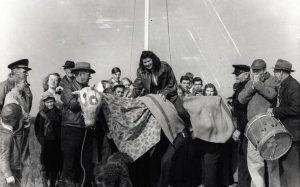 Every place develops traditions that mark it as different or unusual, something that indicates that it is truly distinctive from any other place. The celebration of Old Christmas at the Hatteras Island Village of Rodanthe, though, seems to have taken that to another level. It is an observance that goes back to colonial times but its roots can be traced much farther into the past.Isolated, stubborn and independent, when word finally reached the people living in Rodanthe that Great Britain had adopted the Gregorian Calendar—it's what we use today—in 1752, they chose to ignore it. As a consequence a wonderful tradition has survived for more than 260 years—the Rodanthe Old Christmas.Originally the date of the Old Christmas observation was 11 days after Christmas, but as families grew and spread across the nation, the date of the celebration was changed to the first Saturday after the Epiphany—Saturday, January 6 in 2018, which happens to be the Epiphany in this case.The reason for the discrepancy between the traditional December 25 Christmas and the Rodanthe Old Christmas offers a fascinating glimpse into the politics and religion of the 16th, 17th and 18th centuries.Beginning 46 BC, Europe had been using the Julian Calendar that Julius Caesar had created. The calendar, based on solar cycles instead of lunar cycles was far superior to any other method for measuring the length of a year in use at that time. Unfortunately the calculations were off by slightly more than 11 minutes per year, or one day every 128 years. After two or three centuries—not much of a difference; after 15 or 16 centuries the discrepancy was ten days and seasons are no longer falling where they are supposed to and scheduling religious holidays had become confusing.Pope Gregory XIII cast a wide net to resolve the problem and an Italian scientist by the name of Aloysus Lilius came up with an ingenious solution that we are still using today. Gregory ordered all Catholic nations to implement the new calendar in 1582, deleting 10 days between October 4 and 15 to account for the missing time.Although the Gregorian calendar was clearly superior to the Julian Calendar, England, which had just fought a horrific civil war between Catholics and Protestants and was fighting to gain a foothold in the New World against Catholic nations, was not about to adapt any innovation sponsored by the Pope.The last major European nation to do so, it took 170 years for the British to finally adapt the Gregorian calendar, and even then it was decried by many as a papist conspiracy. To make up for the now 11 days of discrepancy between the true solar year and the Julian calendar, Parliament decreed that the dates of September 3 through September 13, 1752 simply didn't exist.In 1752, when the law took effect, Rodanthe was an isolated village whose residents were almost exclusively descendents of British settlers. It is unclear when they were told of the change in dates. What seems to be clear, though, is that they simply ignored it and went on with their lives.As a consequence, the Rodanthe villagers celebrated Christmas 11 days after the "new" Christmas—as it was called at the time.Although there are no records of how the day was celebrated in the 18th century in the village, records of what happened on the Rodanthe Christmas Day dating to the early 1800s tell of a celebration including food, silliness and Old Buck. Those traditions continue to the present day with lots of food, including steamed oysters, games, music and Old Buck. the mythical bull.Old Buck is an interesting figure. The story goes that he swam ashore from a shipwreck, found the local cows to his liking and took up residence on Hatteras Island. He was either shot and became part of a feast or disappeared in to the forests of the island, but either way, on Old Christmas his spirit reappears every year in the form of a bulls head with a cloth covered body.If there was any doubt that the Rodanthe Old Christmas is directly linked to England, the appearance of Old Buck puts that to rest. A common tradition in Great Britain, dating to the earliest days of Christianity includes eyewitness accounts of celebrations featuring the likeness of animals.An 1883 article published in the British journal Antiquarian Chronicle reports, "There is another custom very common in Cheshire called Old Hob; it consists of a man carrying a dead horse's head, covered with a sheet, to frighten people." From Wales, comes the midwinter tradition of Mari Lwyd, meaning gray mare in English.The use of skulls and animal heads has evolved and Old Buck is more of a representation of a once mighty bull than the real thing, but the date of the celebration and the origin of the traditions recall a time and place unlike the 21st century Outer Banks.The celebrations have gone through some changes over the years. At one time Old Christmas was when grudges and resentments built up over the past year were resolved...often, according to reports with a black eye. There were also rituals allowing a young lady to see her possible husband for the first time; and sometimes men would dress as women and women as men.It is a bit more tame now, but still a remarkable journey into tradition and community spirit.The Rodanthe Old Christmas is held every year at the Rodanthe Community Center.
Every place develops traditions that mark it as different or unusual, something that indicates that it is truly distinctive from any other place. The celebration of Old Christmas at the Hatteras Island Village of Rodanthe, though, seems to have taken that to another level. It is an observance that goes back to colonial times but its roots can be traced much farther into the past.Isolated, stubborn and independent, when word finally reached the people living in Rodanthe that Great Britain had adopted the Gregorian Calendar—it's what we use today—in 1752, they chose to ignore it. As a consequence a wonderful tradition has survived for more than 260 years—the Rodanthe Old Christmas.Originally the date of the Old Christmas observation was 11 days after Christmas, but as families grew and spread across the nation, the date of the celebration was changed to the first Saturday after the Epiphany—Saturday, January 6 in 2018, which happens to be the Epiphany in this case.The reason for the discrepancy between the traditional December 25 Christmas and the Rodanthe Old Christmas offers a fascinating glimpse into the politics and religion of the 16th, 17th and 18th centuries.Beginning 46 BC, Europe had been using the Julian Calendar that Julius Caesar had created. The calendar, based on solar cycles instead of lunar cycles was far superior to any other method for measuring the length of a year in use at that time. Unfortunately the calculations were off by slightly more than 11 minutes per year, or one day every 128 years. After two or three centuries—not much of a difference; after 15 or 16 centuries the discrepancy was ten days and seasons are no longer falling where they are supposed to and scheduling religious holidays had become confusing.Pope Gregory XIII cast a wide net to resolve the problem and an Italian scientist by the name of Aloysus Lilius came up with an ingenious solution that we are still using today. Gregory ordered all Catholic nations to implement the new calendar in 1582, deleting 10 days between October 4 and 15 to account for the missing time.Although the Gregorian calendar was clearly superior to the Julian Calendar, England, which had just fought a horrific civil war between Catholics and Protestants and was fighting to gain a foothold in the New World against Catholic nations, was not about to adapt any innovation sponsored by the Pope.The last major European nation to do so, it took 170 years for the British to finally adapt the Gregorian calendar, and even then it was decried by many as a papist conspiracy. To make up for the now 11 days of discrepancy between the true solar year and the Julian calendar, Parliament decreed that the dates of September 3 through September 13, 1752 simply didn't exist.In 1752, when the law took effect, Rodanthe was an isolated village whose residents were almost exclusively descendents of British settlers. It is unclear when they were told of the change in dates. What seems to be clear, though, is that they simply ignored it and went on with their lives.As a consequence, the Rodanthe villagers celebrated Christmas 11 days after the "new" Christmas—as it was called at the time.Although there are no records of how the day was celebrated in the 18th century in the village, records of what happened on the Rodanthe Christmas Day dating to the early 1800s tell of a celebration including food, silliness and Old Buck. Those traditions continue to the present day with lots of food, including steamed oysters, games, music and Old Buck. the mythical bull.Old Buck is an interesting figure. The story goes that he swam ashore from a shipwreck, found the local cows to his liking and took up residence on Hatteras Island. He was either shot and became part of a feast or disappeared in to the forests of the island, but either way, on Old Christmas his spirit reappears every year in the form of a bulls head with a cloth covered body.If there was any doubt that the Rodanthe Old Christmas is directly linked to England, the appearance of Old Buck puts that to rest. A common tradition in Great Britain, dating to the earliest days of Christianity includes eyewitness accounts of celebrations featuring the likeness of animals.An 1883 article published in the British journal Antiquarian Chronicle reports, "There is another custom very common in Cheshire called Old Hob; it consists of a man carrying a dead horse's head, covered with a sheet, to frighten people." From Wales, comes the midwinter tradition of Mari Lwyd, meaning gray mare in English.The use of skulls and animal heads has evolved and Old Buck is more of a representation of a once mighty bull than the real thing, but the date of the celebration and the origin of the traditions recall a time and place unlike the 21st century Outer Banks.The celebrations have gone through some changes over the years. At one time Old Christmas was when grudges and resentments built up over the past year were resolved...often, according to reports with a black eye. There were also rituals allowing a young lady to see her possible husband for the first time; and sometimes men would dress as women and women as men.It is a bit more tame now, but still a remarkable journey into tradition and community spirit.The Rodanthe Old Christmas is held every year at the Rodanthe Community Center.
Posted by Outer Banks Blue
Rodanthe Old Christmas Is Older Than Rodanthe
 Every place develops traditions that mark it as different or unusual, something that indicates that it is truly distinctive from any other place. The celebration of Old Christmas at the Hatteras Island Village of Rodanthe, though, seems to have taken that to another level. It is an observance that goes back to colonial times but its roots can be traced much farther into the past.Isolated, stubborn and independent, when word finally reached the people living in Rodanthe that Great Britain had adopted the Gregorian Calendar—it's what we use today—in 1752, they chose to ignore it. As a consequence a wonderful tradition has survived for more than 260 years—the Rodanthe Old Christmas.Originally the date of the Old Christmas observation was 11 days after Christmas, but as families grew and spread across the nation, the date of the celebration was changed to the first Saturday after the Epiphany—Saturday, January 6 in 2018, which happens to be the Epiphany in this case.The reason for the discrepancy between the traditional December 25 Christmas and the Rodanthe Old Christmas offers a fascinating glimpse into the politics and religion of the 16th, 17th and 18th centuries.Beginning 46 BC, Europe had been using the Julian Calendar that Julius Caesar had created. The calendar, based on solar cycles instead of lunar cycles was far superior to any other method for measuring the length of a year in use at that time. Unfortunately the calculations were off by slightly more than 11 minutes per year, or one day every 128 years. After two or three centuries—not much of a difference; after 15 or 16 centuries the discrepancy was ten days and seasons are no longer falling where they are supposed to and scheduling religious holidays had become confusing.Pope Gregory XIII cast a wide net to resolve the problem and an Italian scientist by the name of Aloysus Lilius came up with an ingenious solution that we are still using today. Gregory ordered all Catholic nations to implement the new calendar in 1582, deleting 10 days between October 4 and 15 to account for the missing time.Although the Gregorian calendar was clearly superior to the Julian Calendar, England, which had just fought a horrific civil war between Catholics and Protestants and was fighting to gain a foothold in the New World against Catholic nations, was not about to adapt any innovation sponsored by the Pope.The last major European nation to do so, it took 170 years for the British to finally adapt the Gregorian calendar, and even then it was decried by many as a papist conspiracy. To make up for the now 11 days of discrepancy between the true solar year and the Julian calendar, Parliament decreed that the dates of September 3 through September 13, 1752 simply didn't exist.In 1752, when the law took effect, Rodanthe was an isolated village whose residents were almost exclusively descendents of British settlers. It is unclear when they were told of the change in dates. What seems to be clear, though, is that they simply ignored it and went on with their lives.As a consequence, the Rodanthe villagers celebrated Christmas 11 days after the "new" Christmas—as it was called at the time.Although there are no records of how the day was celebrated in the 18th century in the village, records of what happened on the Rodanthe Christmas Day dating to the early 1800s tell of a celebration including food, silliness and Old Buck. Those traditions continue to the present day with lots of food, including steamed oysters, games, music and Old Buck. the mythical bull.Old Buck is an interesting figure. The story goes that he swam ashore from a shipwreck, found the local cows to his liking and took up residence on Hatteras Island. He was either shot and became part of a feast or disappeared in to the forests of the island, but either way, on Old Christmas his spirit reappears every year in the form of a bulls head with a cloth covered body.If there was any doubt that the Rodanthe Old Christmas is directly linked to England, the appearance of Old Buck puts that to rest. A common tradition in Great Britain, dating to the earliest days of Christianity includes eyewitness accounts of celebrations featuring the likeness of animals.An 1883 article published in the British journal Antiquarian Chronicle reports, "There is another custom very common in Cheshire called Old Hob; it consists of a man carrying a dead horse's head, covered with a sheet, to frighten people." From Wales, comes the midwinter tradition of Mari Lwyd, meaning gray mare in English.The use of skulls and animal heads has evolved and Old Buck is more of a representation of a once mighty bull than the real thing, but the date of the celebration and the origin of the traditions recall a time and place unlike the 21st century Outer Banks.The celebrations have gone through some changes over the years. At one time Old Christmas was when grudges and resentments built up over the past year were resolved...often, according to reports with a black eye. There were also rituals allowing a young lady to see her possible husband for the first time; and sometimes men would dress as women and women as men.It is a bit more tame now, but still a remarkable journey into tradition and community spirit.The Rodanthe Old Christmas is held every year at the Rodanthe Community Center.
Every place develops traditions that mark it as different or unusual, something that indicates that it is truly distinctive from any other place. The celebration of Old Christmas at the Hatteras Island Village of Rodanthe, though, seems to have taken that to another level. It is an observance that goes back to colonial times but its roots can be traced much farther into the past.Isolated, stubborn and independent, when word finally reached the people living in Rodanthe that Great Britain had adopted the Gregorian Calendar—it's what we use today—in 1752, they chose to ignore it. As a consequence a wonderful tradition has survived for more than 260 years—the Rodanthe Old Christmas.Originally the date of the Old Christmas observation was 11 days after Christmas, but as families grew and spread across the nation, the date of the celebration was changed to the first Saturday after the Epiphany—Saturday, January 6 in 2018, which happens to be the Epiphany in this case.The reason for the discrepancy between the traditional December 25 Christmas and the Rodanthe Old Christmas offers a fascinating glimpse into the politics and religion of the 16th, 17th and 18th centuries.Beginning 46 BC, Europe had been using the Julian Calendar that Julius Caesar had created. The calendar, based on solar cycles instead of lunar cycles was far superior to any other method for measuring the length of a year in use at that time. Unfortunately the calculations were off by slightly more than 11 minutes per year, or one day every 128 years. After two or three centuries—not much of a difference; after 15 or 16 centuries the discrepancy was ten days and seasons are no longer falling where they are supposed to and scheduling religious holidays had become confusing.Pope Gregory XIII cast a wide net to resolve the problem and an Italian scientist by the name of Aloysus Lilius came up with an ingenious solution that we are still using today. Gregory ordered all Catholic nations to implement the new calendar in 1582, deleting 10 days between October 4 and 15 to account for the missing time.Although the Gregorian calendar was clearly superior to the Julian Calendar, England, which had just fought a horrific civil war between Catholics and Protestants and was fighting to gain a foothold in the New World against Catholic nations, was not about to adapt any innovation sponsored by the Pope.The last major European nation to do so, it took 170 years for the British to finally adapt the Gregorian calendar, and even then it was decried by many as a papist conspiracy. To make up for the now 11 days of discrepancy between the true solar year and the Julian calendar, Parliament decreed that the dates of September 3 through September 13, 1752 simply didn't exist.In 1752, when the law took effect, Rodanthe was an isolated village whose residents were almost exclusively descendents of British settlers. It is unclear when they were told of the change in dates. What seems to be clear, though, is that they simply ignored it and went on with their lives.As a consequence, the Rodanthe villagers celebrated Christmas 11 days after the "new" Christmas—as it was called at the time.Although there are no records of how the day was celebrated in the 18th century in the village, records of what happened on the Rodanthe Christmas Day dating to the early 1800s tell of a celebration including food, silliness and Old Buck. Those traditions continue to the present day with lots of food, including steamed oysters, games, music and Old Buck. the mythical bull.Old Buck is an interesting figure. The story goes that he swam ashore from a shipwreck, found the local cows to his liking and took up residence on Hatteras Island. He was either shot and became part of a feast or disappeared in to the forests of the island, but either way, on Old Christmas his spirit reappears every year in the form of a bulls head with a cloth covered body.If there was any doubt that the Rodanthe Old Christmas is directly linked to England, the appearance of Old Buck puts that to rest. A common tradition in Great Britain, dating to the earliest days of Christianity includes eyewitness accounts of celebrations featuring the likeness of animals.An 1883 article published in the British journal Antiquarian Chronicle reports, "There is another custom very common in Cheshire called Old Hob; it consists of a man carrying a dead horse's head, covered with a sheet, to frighten people." From Wales, comes the midwinter tradition of Mari Lwyd, meaning gray mare in English.The use of skulls and animal heads has evolved and Old Buck is more of a representation of a once mighty bull than the real thing, but the date of the celebration and the origin of the traditions recall a time and place unlike the 21st century Outer Banks.The celebrations have gone through some changes over the years. At one time Old Christmas was when grudges and resentments built up over the past year were resolved...often, according to reports with a black eye. There were also rituals allowing a young lady to see her possible husband for the first time; and sometimes men would dress as women and women as men.It is a bit more tame now, but still a remarkable journey into tradition and community spirit.The Rodanthe Old Christmas is held every year at the Rodanthe Community Center.







